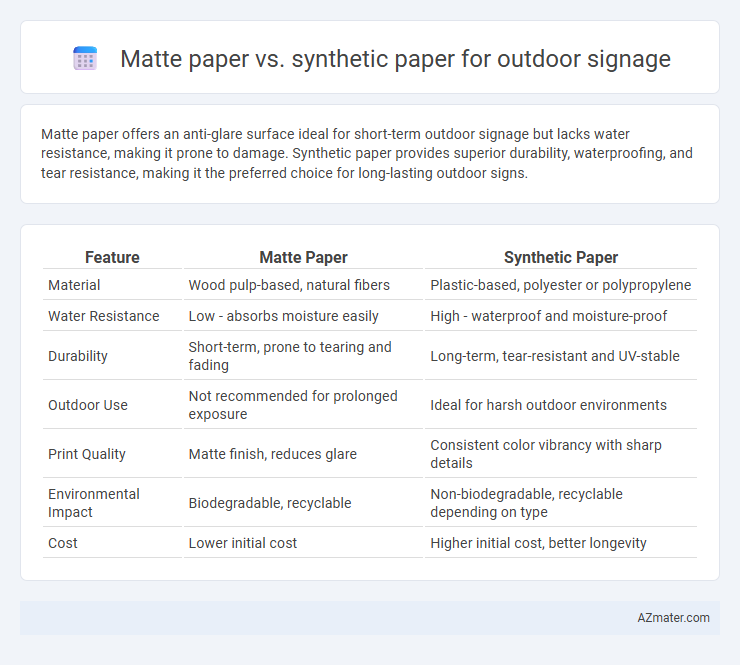Matte paper offers an anti-glare surface ideal for short-term outdoor signage but lacks water resistance, making it prone to damage. Synthetic paper provides superior durability, waterproofing, and tear resistance, making it the preferred choice for long-lasting outdoor signs.
Table of Comparison
| Feature | Matte Paper | Synthetic Paper |
|---|---|---|
| Material | Wood pulp-based, natural fibers | Plastic-based, polyester or polypropylene |
| Water Resistance | Low - absorbs moisture easily | High - waterproof and moisture-proof |
| Durability | Short-term, prone to tearing and fading | Long-term, tear-resistant and UV-stable |
| Outdoor Use | Not recommended for prolonged exposure | Ideal for harsh outdoor environments |
| Print Quality | Matte finish, reduces glare | Consistent color vibrancy with sharp details |
| Environmental Impact | Biodegradable, recyclable | Non-biodegradable, recyclable depending on type |
| Cost | Lower initial cost | Higher initial cost, better longevity |
Introduction to Outdoor Signage Material Choices
Matte paper offers a non-reflective surface ideal for reducing glare in outdoor signage, but it lacks durability against weather elements, making it less suitable for long-term use. Synthetic paper, composed of durable plastic materials like polypropylene, provides superior water resistance, tear strength, and UV protection, ensuring vibrant, lasting outdoor displays. Choosing between matte and synthetic paper depends on the required durability, weather exposure, and visual presentation priorities for effective outdoor signage solutions.
What is Matte Paper?
Matte paper is a non-glossy, smooth-surfaced paper commonly used for outdoor signage due to its ability to reduce glare and improve readability under direct sunlight. Its porous texture allows for excellent ink absorption, resulting in sharp, vibrant images without reflective interference. Compared to synthetic paper, matte paper is less water-resistant and more prone to damage from harsh weather conditions.
What is Synthetic Paper?
Synthetic paper is a durable, tear-resistant material made from plastic polymers such as polypropylene or polyethylene, designed to withstand harsh outdoor conditions. It offers superior water resistance, UV resistance, and longevity compared to traditional matte paper, making it ideal for outdoor signage exposed to weather elements. Unlike matte paper, synthetic paper combines the look and feel of regular paper with the strength and flexibility of plastic, ensuring vibrant print quality and extended durability.
Durability: Matte Paper vs Synthetic Paper
Matte paper offers moderate durability but is prone to water damage, tearing, and fading when exposed to harsh outdoor conditions. Synthetic paper, made from waterproof and tear-resistant materials, provides superior durability and withstands UV rays, moisture, and extreme weather without degrading. For long-lasting outdoor signage, synthetic paper ensures enhanced longevity and consistent image quality compared to matte paper.
Weather Resistance Comparison
Matte paper offers limited weather resistance, as it tends to absorb moisture and degrade quickly under rain and UV exposure, making it less suitable for outdoor signage applications. Synthetic paper, composed of durable polymers like polypropylene, provides superior resistance to water, tearing, and fading, ensuring long-lasting performance even in harsh weather conditions. Its robust construction maintains print quality and structural integrity, making synthetic paper the preferred choice for outdoor signage demanding high weather resistance.
Print Quality and Color Vibrancy
Matte paper offers a non-reflective surface that reduces glare, producing clear and readable outdoor signage, but its color vibrancy tends to be more muted compared to synthetic paper. Synthetic paper, made from waterproof and tear-resistant materials like polypropylene, provides superior color saturation and brightness, enhancing the vibrancy and longevity of prints in outdoor conditions. For outdoor signage requiring high durability and vivid colors, synthetic paper ensures more impactful and weather-resistant visuals than traditional matte paper.
Cost Analysis: Which Material is More Economical?
Matte paper offers a lower initial cost compared to synthetic paper, making it attractive for short-term outdoor signage projects where budget constraints are critical. Synthetic paper, while more expensive upfront, provides enhanced durability, water resistance, and longer lifespan, reducing replacement frequency and overall maintenance expenses. Considering total cost of ownership, synthetic paper often proves more economical for long-term or high-exposure outdoor signage due to its resilience and reduced need for frequent replacements.
Eco-Friendliness and Sustainability Factors
Matte paper is biodegradable and typically made from natural fibers, making it a more eco-friendly option for outdoor signage with easier recyclability and composting potential. Synthetic paper, while offering superior durability and water resistance, is often composed of plastic-based materials that pose challenges in biodegradability and recycling processes. Choosing matte paper enhances sustainability efforts by reducing long-term environmental impact despite a shorter lifespan, whereas synthetic paper prioritizes longevity, potentially increasing waste accumulation.
Application Suitability for Outdoor Use
Matte paper offers a non-reflective surface ideal for readable outdoor signage but lacks durability against weather elements like rain and UV exposure, making it less suitable for long-term outdoor use. Synthetic paper, made from durable plastic materials, provides superior resistance to water, tearing, and fading, ensuring prolonged visibility and performance in harsh outdoor conditions. For applications requiring robustness and longevity in outdoor environments, synthetic paper is the preferred choice over matte paper.
Final Verdict: Choosing the Right Material for Outdoor Signage
Matte paper offers excellent print clarity and reduces glare, making it a suitable choice for short-term outdoor signage in shaded or low-light environments. Synthetic paper, crafted from waterproof and tear-resistant materials, excels in durability and weather resistance, ideal for long-term outdoor applications exposed to harsh elements. For outdoor signage requiring longevity and resilience, synthetic paper is the optimal choice, while matte paper serves well for temporary, cost-effective solutions.

Infographic: Matte paper vs Synthetic paper for Outdoor signage
 azmater.com
azmater.com